#ludonarrative harmony
Explore tagged Tumblr posts
Text
Progress Takes Patience - My Thoughts on The Casting of Frank Stone
Warning(s) for: spoilers.
Horror of your choosing in this game transpires within an omniversal narrative framework that is deserving of recognition for recontextualizing what are unsatisfying erasures of already-experienced plots elsewhere as a lore-friendly exploration of divergences here. Remaining aware of the improvement that has been made to this sort of story's structure within the confines of this fiction, it is my hope that its potential that is tarnished now due to an inability to initiate those explorations scene by scene is fully realized by future titles of this ilk.
#the casting of frank stone#choose your own horror#dead by daylight#dbd#ludonarrative#ludonarrative harmony#video games
3 notes
·
View notes
Text
And then he brings back Wurmcoil Engine and everybody laughs because the card leaves such a strong narrative impression it supercedes the gameplay
Feldon of the Third Path is, in my opinion, the pinnacle of storytelling in Magic: The Gathering.
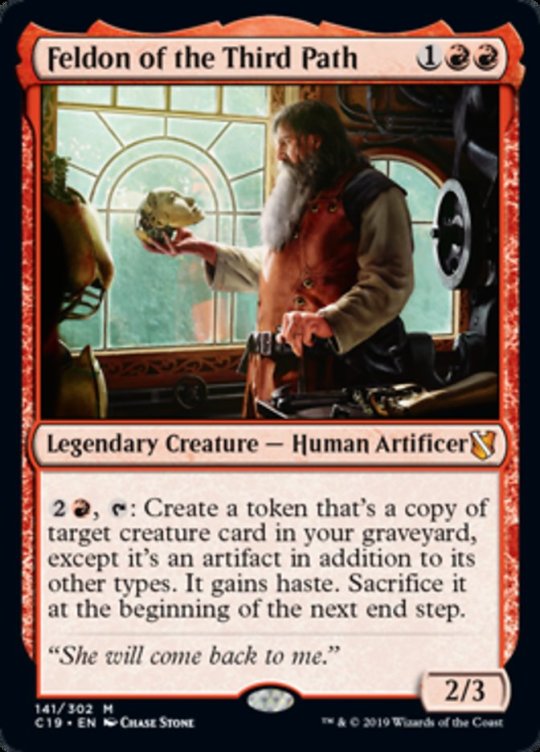
Every part of this card comes together to tell you Feldon's story without ever overtly saying anything.
The art depicts him as a sturdy man, used to labor, and the workshop around him supports that. His hair is dark, but his beard is gray. He's getting older, but there's life in him yet. He gazes intensely at at the machined face of an automaton's head.
His ability doesn't do anything so gauche as bringing a card back from the graveyard. No, he targets a card in the graveyard -- someone, something that has died -- and and creates a copy, a facsimile, that's an artifact in addition to whatever it was before. But his creation is imperfect. It doesn't last. At the end of the turn, you sacrifice the copy. Greater magics than what Feldon posseses are required to make it stay more than a moment.
And then the flavor text. "She will come back to me." Powerful. Defiant. Sorrowful. Broken? Who can say, we haven't heard Feldon himself speak the words. But he lost someone, and he is determined, driven to bring her back the only way he knows how.
We're never told what the first two paths are, even if we can assume, but Feldon very clearly indicates what the Third Path is.
#Magic: The Gathering#Magic The Gathering#Feldon#Chase Stone#Feldon of the Third Path#ludonarrative harmony
2K notes
·
View notes
Text
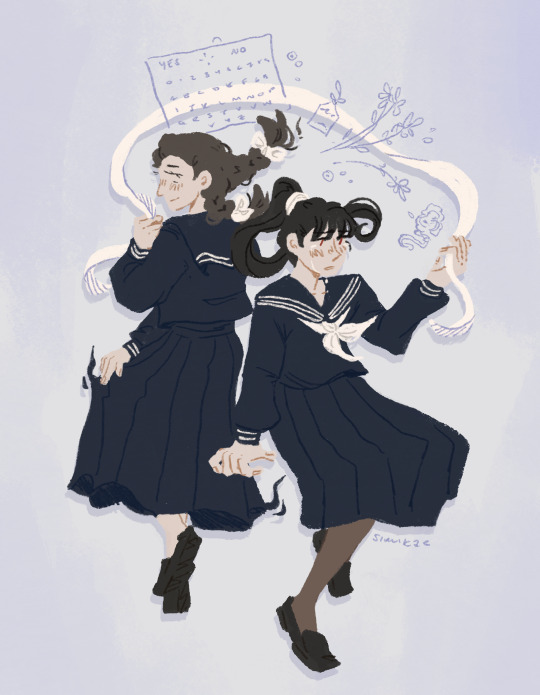
four hundred and ninety yen
#paranormasight#my art#my finished stuff#LONG SUFFERING SIGH FROM THE PEANUT GALLERY AS I GET INTO ANOTHER RANDOM ASS VN#anyway.#such a wonderful game was so so enraptured with it. everything abt it appealed to me specifically#from the mystery genre to the themes of grief and living to the presentation to the ludonarrative harmony#absolutely shot up to one of my favorite vns ever#all tjat to say. PLEASE check out the summary and get it if it sparks an interest at all its so worth it#very unique experience of a vn. love love love it
352 notes
·
View notes
Text
i had a psychoeducational assessment yesterday and they made me write an essay in 10 minutes. the topic was to write about your favorite game of any kind and cite 3 reasons.
i wrote about celeste because it was the only one of my favs that i was certain i could summarize in 10 minutes. as soon as time ran out it occurred to me that i had showed up to a mental health evaluation in a celeste hoodie and infodumped about celeste. like fuck man im actually a cartoon character
#celeste game#auri yaps#i dont get the report until next week but there were almost certainly Some deductions made#i did consider writing about p5 but i cant do that without writing a secondary essay about every member of the cast#and i cant write about isat without going on a long side tangent about ludonarrative harmony
11 notes
·
View notes
Text
outer wilds is like if an elementary school science class was a video game. you know what I mean? kids love science. they love being curious and seeing cool things happen and being able to know why they happened. eventually science becomes more and more separated from play as you get older and learn that everything is actually really complicated all of the time, and that's a pretty sad effect of adulthood because it used to be so fun. but then outer wilds is like, I made some figurative test tubes you can combine and some figurative dinosaurs you can study ::)
#outer wilds#I don't think the nomai are supposed to be like dinosaurs but it worked for the post#I think they're so cute though the game is like we will give you a supportive scientific community to watch over you from heaven#ludonarrative harmony that's not about hardship + game is hard for once
9 notes
·
View notes
Text
Welp, today it's Dark Souls 2's "irrational" placement of areas
like, the infamous elevator going from Earthen Peak, a valley downhill, "up" to the bottom of the lava-submerged Iron Keep or running below sea level from Heide's Tower "down to" No Man's Wharf being above sea level.
It's good actually. Cause it's ludonarrative harmony/consonance
First off, why? Like why care about this? Those who like DS2 might already accept it as is and those who don't would write it off as bad design. Regardless, I hope that this interpretation is interesting. It might not be canon or accurate or full of holes, but if it gives you some thoughts about how your next DS2 playthrough can be different then this interpretation does its purpose.
Taking DS2 out of the franchise and just as a standalone game, it does one thing well in the way Half-Life or GTA does its story world well: the "sandbox". Whatever the player does to the world, there is a consequence that feeds back into that action, acknowledging and recording that the player does it. Not just consequence, but recording in the way that it creates an emergent narrative about what the character, controlled by the player, becomes. The famous example in Half-Life is if you pay attention to the story, you get to engage with the lore. Your character can save people and be rewarded, or be homicidal and also be rewarded, and the surrounding people run away from your character screaming. The world took note of your character's action and reacted to the character accordingly. By building a "reputation" for your character, the game world assigned them "an identity". (Half Life Example: Raycevick's The Orange Box...10 Years Later)
DS2 does this. There are Youtubers doing lore content, reading every piece of item description to try and extract information about the world. There are challenge runners who "bear, seek, seek, lest" and watching their runs, one never understand what the game is about. If one goes on to r/darksouls2 looking for tips, then one comes into the game probably knowing more about the stats and weapons and killing than why some enemies ragdoll and most other vanished (including your own character). Simply put, no matter what you the player choose, the game world has a way to reward and engage with your play style, or rather your way of engaging with the game and its world, by reward and engage with your character's action.
This is ludonarrative harmony (or consonance, as opposed to dissonance). The quick and dirty is when gameplay and story aim to do the same thing, as opposed to when gameplay does one thing and story does another, often in direct contradiction to each other. For contrast, examples of ludonarrative disonnance is well this ProZD's video, or when the game has you be overpowered gods then got tickled to death in a cutscene, or preaching to be a pacifist during cutscene and dialogue only to make sure the number of living thing around you is 0. So compared this to DS2, however you want to play the game, your character's story and and action is aligned or in harmony. That's intentional and is good design.
So what does this have to do with areas placement? Why Aldia's Keep opens to a cliff on top of mountains?
One of the many themes or possible interpretations of DS2 is the focus on the player character being undead, destined to lose memory and become hollow. Simply put, the world designs reinforce this aspect, creating the sense that the character through whose eyes you see the world hollowing. Specifically, it is done through things that are in-the-face, such as having a long connection between the previous area's boss to the next area's first bonfire, the seemingly impossible physics of "up and down", and the frozen time (always sunny in Majula, always twilight-moonrise in Huntsman's Copse, etc.), but also other mechanics that are more subtle and can be easily accepted as "game mechanic". The repeated dying and respawning of enemies, the New Game plus, both through ascetic or restarting at Majula, etc. few things are permanently changed, even the result of the supposed ending (linking the fire or walking away) can be undone by NG+. They all added to the sense of what it's like being hollow. We hear this from other NPC who arrived and pursued their own journeys but slowly and gradually forgetting why they were here, only that they're here (which, isn't that's why we the players are here?).
I'd argue at the surface level, this is simply good design to communicate the overarching feeling of being in this world, a sense of melancholy exploring an already dead world, almost dystopian because the character and everyone in it is trapped in a loop, but at the same time finding some personal objective to help push one forward. But take it to the next level, this design makes sure that no matter how you want to play the game, your character stays consistent narratively. Your character is a conduit to tell the story of the world of Dark Soul 2. The story is there, even if you choose not to engage with it.
Accepting this argument, then the intentional design of the world and the lore of DS2 provides the added benefit of arguably having all of the lore explanation for every game mechanics. I wouldn't say that all game mechanics will have an accurate lore explanation, but I would say this design allow all game mechanics to have a lore "consistent" explanation. Everything should point to "this is what being hollow is like, this is what the world is like to the hollow".
I haven't played through any other entry in the series (Elden Ring is temping a hunger I have fought for years lol) but at least for DS2, I appreciate the design that turns Mario-esque "grassland, desert, forest, jungle, ice world, fire world, boss" into a gateway into a fantastical land.
And yeah, I understand that this design, in real life, is due to industry trademarked deadline/need to ship product/budget, timeline, very real thing issues, etc. But this will be my headcannon that in the real life error and creative constraints , Miyazaki and his team found us a great example of game meets design meets story.
p/s: originally posted this take on reddit, reposted here with some edits
#dark souls 2#ds2#fromsoftware#hidetaka miyazaki#ludonarrative consonance#luronarrative harmony#ludonarrative dissonance#raycevick#prozd#elden ring
4 notes
·
View notes
Text
Sonic CD might be becoming my favorite classic Sonic game , ,,,,,

#sth#shut the heck up#sonic hot takes#sonic cd#no like i actually like sonic as a momentum.based puzzle platformer??????#with GODLY music and incredibly colorful and striking art design????#and a natural sense ludonarrative harmony with the time travel as a gimmick and solarpunk theme?????#if you can understand it it all comes together into a really fucking unique and kinda un-sonic but SUPER fun experience what#tag talking
1 note
·
View note
Text
Good news; the p3r review script will be much kinder than anticipated (MY CURSED EYE HAS STOPPED GLOWING AND THE HATER URGE HAS LEFT MY BODY)
No, I'm not crossing out the 5 minute rant about not having an original/remix soundtrack toggle or the 15 minute rant about how tactics-focused combat is a more interesting take on turn-based systems than direct commands, atlus deserves those
#not to mention#the parts of the soul they remastered away helped with LUDONARRATIVE HARMONY#in a game about FORMING BONDS and TALKING TO OTHERS you should have to plan around your party not listening to what you want
0 notes
Text

I LOVE THEMATIC COHERENCE!!!! I LOVE THAT THE STORY OF THE GAME TOOK THE WACKY PREMISE OF THE GAME, ENDLESSLY FIGHTING OVER NOTHING, AND TREATED IT WITH A PRECISION-CALIBRATED BALANCE OF COMEDY AND DRAMA!!! OF COURSE IT WAS ALWAYS ABOUT SPITE FOR SPITE'S SAKE!!!! IT COULD HAVE NEVER POSSIBLY BEEN ABOUT ANYTHING ELSE!!!! LETS HEAR IT FOR LUDONARRATIVE HARMONY WOOOOOOOOOOO
#tf2#this is scratching the same itch i've had since the last episode of tales from the borderlands in 2015#i feel like when sports fans riot because their team won
1K notes
·
View notes
Text
There’s always going to be a ludonarrative disconnect between a series where harmony with nature and natural preservation is a core theme yet killing and farming hundreds of monsters for loot and pleasure is the core gameplay loop
But I think Wilds has at least struck a strong balance on the narrative front this time by making it seem like harming monsters is something that Hunters and the Guild are genuinely reluctant to do.
The research element is in strong focus, perhaps even more so than in World where it wa s ostensibly the very center of the entire expedition- the Wilds expedition makes every effort to try to learn more about this local environment and you are almost never given a quest that starts with the objective of fighting a monster until high rank- almost every monster you fight during the course of the story is an immediate danger to yourself or others and there are few alternatives to pacifying it.
The Authorizations that are then handed down by handlers feel like they have more meaning than just set dressing, and the more fleshed out characters help reinforce how serious the authorization to Hunt a monster is- no one wants to do this, it’s no one’s first choice and everyone in the expedition feels that way.
Which makes them all the more impactful when you do, and builds up enough narrative goodwill that when you reach High Rank and start spending more time hunting monsters for looser reasons, it doesn’t immediately feel quite as obviously frivolous. You still keep getting sprinkled with story quests that highlight the potential dangers and ecological need for slaying or capturing a monster, but it’s the work done beforehand that helps those work as reinforcements rather than justification alone.
It’s really cool to see and makes the world all that much more immersive.
559 notes
·
View notes
Text
isat is praised a lot for its ludonarrative harmony and how the player's feelings are synchronised with siffrin's, but something i don't see mentioned much is how it also works the other way around -- the player trying to get certain dialogues/interactions (the player's influence on siffrin's actions), even if they go against siffrin's wants at the moment, are all justified in game.
for example, if the player continuously attempts to use siffrin's dagger on their allies, siffrin is having intrusive thoughts. and if the player repeatedly tries to go into the bathroom in act 5, siffrin secretly really wanted to monologue because he's a little obsessed with them lol
#isat spoilers#in stars and time#isat#siffrin isat#my ramblings#it reminds me a little of the player's influence in deltarune and how the concept is handled in opposite directions#in deltarune the player is explicitly a separate being from kris & the player can sometimes control kris's actions against their will#while in isat the player IS siffrin. there's no separation; the player's actions/impulses are justified through siffrin's thought processes
629 notes
·
View notes
Note
i typed this up last night and queued it for this morning, and looking at it again now i noticed something:
the three characters who are, by virtue only of the state of their existence, most unable to have an impact on the world, to connect with (other) humans —the two pets and the living ghost (yomiel) — are the ones who get ghost tricks. in other words, the ones who are arguably least able to impact things by natural means are the ones who get the ability to impact things via supernatural means.
and that has me thinking about that early exchange between lynne, ray, and sissel. where lynne laments how "unfair" it is that only a special few get ghost powers, because if she had them, they could help her to solve her case (to save jowd). and sissel says, well, i'd rather be in your position — because you can come back from death, as many times as it takes.
lynne often feels helpess, with how jowd and cabanela refuse to let her help, to take her mission seriously; but she at least has connections with others, people who can hear her and help her, where the amnesiac sissel has none. it's through her, through the bond she forms with sissel and the task she assigns to him, that sissel connects with the other mains. and it's her determination, her hope and faith in others (even when they refuse to believe in themselves), that paves the way to the game's happy ending.
there are different forms of influence, of "power", of "strength".
in the rue golberg-esque plot of ghost trick, everyone has their own part to play. and it's only when every piece is in place that fate can be averted.
(@four-minutes-before-death)
You ever think about how Yomiel's ten year hell (Alone, noticed by no one except his only friend, unable to make any significant mark on the world) is how Sissel spent his entire life?
Because I do, and it fucks me up a normal amount (lying).
(i didn't think i'd have a lot to say in response to this but then i did. oops.)
man... sissel. he really thought his whole life that he was helpless to meaningfully help the one person he cared about... the same way missile->ray felt in that og timeline. because they were pets, little animals, in a human world. because there was a communication barrier, a gap of understanding, that they couldn't cross.
(sissel is able to save the day, get the help he needs, when he and everyone around him assume him to be human. and sissel listens to ray the second time around because ray has disguised himself and learned to play the part of the wisened mentor.)
it's not just the pets who feel helpless, though. like you said, yomiel feels entirely cut off from the world; more a ghost, a shadow, than a person. jowd sees himself as being at the mercy of fate because of the bad karma he gained from the life he "stole". and his choice to "confess" leaves all his loved ones feeling helpless as they struggle to uncover the truth and save him from his "fate", no one of them having all the pieces to solve the puzzle.
for as comedic and fun as ghost trick's regular tone is, it's also a story filled with tragedy and despair. and in the face of such circumstances, it's easy to blame it all on higher powers, on fate. to deny, renounce, what agency you actually have.
but, see, that's the trick -- none of the characters in ghost trick are powerless or insignificant (none of the main cast, for sure). their faith, their compassion, their efforts, matter.
you won't always be able to save the ones you love. not on your own. but that doesn't mean they can't be saved. because you're never entirely on your own. not forever. if you keep trying, if you can hold on long enough... even the impossible can happen.
ultimately, the only thing that's "fated" in ghost trick is that these people are connected to each other. the nature of those connections — the details of the events that bring them together — can change.
tragedy is not inevitable. it's man (and animal)–made. and so, too, are happy endings.
#ghost trick#ghost trick: phantom detective#analysis#yomiel#sissel#missile#lynne#when the ludonarrative is harmonious#kamila as a child is also in a position of unique helplessness compared to the rest of the cast#but her getting ghost powers and staying dead long enough to use them would prob upset the tonal balance#...though now that i've had the thought... a part of me does kinda wish the game went there with it...
43 notes
·
View notes
Note
I'm really interested in the mechanics of tabletops, which makes me want to know about the mechanics of disco elysium, but instead of a detailed mechanical analysis I can only (understandably!) find narrative commentary. As a Very Smart Cookie, I would love to hear what you have to say on topics such as... How does disco elysium work? What makes it different than other games? Is it *just* the quality of the writing? How do the mechanics synergize with the quality of the writing?
So okay, it's not just the quality of the writing, although to be fair; the writing is like really good.
But as for the mechanics: Disco Elysium is ultimately a video game. It is clearly inspired heavily by tabletop RPGs, even more so than most CRPGs are (like, Disco Elysium is pretty much a masterclass in terms of how well it manages to make a CRPG feel very close to a tabletop RPG in terms of player expression and the marriage of fiction and mechanics). Disco Elysium's actual game mechanics are not all that remarkable, but the game uses them in such a way that pretty much necessitates it being a video game.
At its core, Disco Elysium's resolution mechanic is based on a roll of two six-sided dice plus a skill rating, trying to roll greater than or equal to a target number determined by the difficulty of the action, and it uses a very traditional type of Pass/Fail method of determining results based on those rolls. It is, at the end of the day, unremarkable as a resolution mechanic. There is something to be said for the distribution of results on the 2d6 and how even a single plus can actually skew the probabilities in the player's favor and how this combined with the fact that the game makes various individual +1 bonuses from drugs and clothes and whatever easily available to the player is a great example of ludonarrative harmony. But ultimately the system isn't one that would exactly make tabletop enthusiasts hoot and holler.
But the game still uses that very simple mechanic effectively, not only because of the aforementioned stacking of bonuses (which is really easy to do in a video game but in a tabletop context often results in tedium) but also because the game is actually doing lots of hidden and rapid fire checks under the hood ALL THE TIME. When in a tabletop RPG you probably shouldn't want to stop the flow of a scene where everyone at the table is jamming and narrating together for the sake of rolling a knowledge check, Disco Elysium is doing that for you all of the time. That is something where the game is making the most out of the fact that it can offload that stuff to the program, to be handled in the background at a rapid fire pace.
There is definitely stuff that can be taken away from Disco Elysium for the sake of tabletop RPGs, but its prose is hard to imitate without sounding pretentious or insincere, and its mechanics would be hard to replicate in a tabletop format because they ultimately rely on a lot of book-keeping that may be tedious to do manually as well as doing LOTS of rolls in the background that could potentially introduce unnecessary friction into gameplay if replicated at the table.
319 notes
·
View notes
Text
ISAT and Ludonarrative Harmony: Combat is a Storytelling Tool
Or: How Siffrin is stuck in the endgame grind, forever
Please Note: This is primarily aimed at an audience that already played In Stars and Time, because I am bad at explaining things, and it's good to already know what the fuck I'm talking about. I tend to only bring up game elements as I want to talk about them.
Spoilers for.... all of ISAT! Especially Act 5!
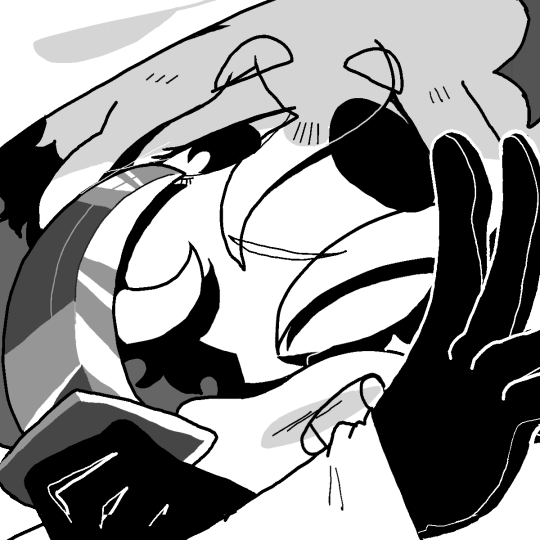
(image to show how i feel posting this and as an attention grabber over my wall of text)
To pull a definition of ludonarrative harmony out of a hat, game writer Lauryn Ash defines it as follows:
Ludonarrative harmony is when gameplay and story work together to create a meaningful and immersive experience. From a design implementation perspective, it is the synchronized interactions between in-game actions (mechanics) and in-world context (story).
It is, generally speaking, how well game mechanics work hand in hand with the story. I, personally, think ISAT is an absolute masterclass of it, so I want to take a look at how ISAT specifically uses its battle system to emphasize Siffrin's character arc and create organic story moments. I want you to keep this in mind when I talk here.
So, skills, right? If you've played any turn-based RPG, you know your Fire spells, your "BACKSLASH! AIRSLASH! BACKSLASH!" and the many ways to style those.
Well, what does casting "Fire" say about your character? Not all that much, does it? Perhaps you'll have typical divisions. The smart one is the mage, the big brawny one is your tank, the petite one's the healer. And that's the barebones of ISAT's main party, but it's much more than that.
Every character's style of combat tells you something about them. Odile, the Researcher, is the most well-travelled and knowledgable of the bunch. She's the one with the expertise to keep a cool head and analyze the enemy, yet also able to use all three of the Rock-Paper-Scissors craft types.
To reflect her analytical view of things, all her skill names are just descriptive, the closest to your most bog-standard RPG. "Slow IV" or "Paper III" serve well to describe their purpose. The high number of the skills gives the impression there were three other Slow skills beforehand - fitting, considering the party starts at level 45, about to head into the final dungeon. She's also the oldest, so she's the slowest of the bunch.
Isabea, the Fighter, has all his skills in exclamation points. "YOUR TURN!!!" "SO WEAK!!!" "SMASH!!!" they're straightforward, but excited. He's a purposefully cheerfull guy, so his skills revolve around cheering on his allies. He's absolutely pumped to be here, and you see that from his skill names alone.
Mirabelle, the Housemaiden, is an interesting case. She's by all means the true protagonist of this tale - She's the one "Chosen by the Change God," the only one who survived the King's first attack, the only one immune to his ability to freeze time, the only dual-craft type of the game - just a lot of things. And her skill names reflect that facade she puts on herself - she can do this, she can win! She has to believe it, or else she starts doubting. This is how you get "Jolly Round Rondo" and "Mega Sparkle Heal" or "Adorable Moving Cure." She's styled every bit a sailor scout shojo heroine, and her moveset replicates the naming conventions of "In the name of the moon, I'll punish you!"
Even Bonnie, the Kid, who can't be controlled in combat, has named craft skills. And they very much reflect that Bonnie is, well, a kid. "Wolf Speed Technique" or "Thousand Blows Technique" are very much the phrasings of a child who learned one complicated word and now wants to use it in everything to seem cooler than they are, which is none, because they're twelve.
Siffrin's skills are all puns.

You have an IMMEDIATE feel for personality here. Between "Knife to Meet You!" and "Too Cleaver by Half," you know Siffrin's the type to always crack a joke no matter the situation, slinging witticisms around to put Sonic the Hedgehog to shame. It's just such a clever way to establish character using a game mechanic as old as the entire history of RPGs.
This is only the baseline of the way the combat system feeds into the story, though.
The timeloop, of course, feeds into it. Siffrin is the only character who retains experience upon looping, whereas all other characters are reset to their base level and skills. And it sucks (affectionate).
You're extremely likely to battle more often the earlier in the game you are - after all, you need the experience (for now.) Every party member contributes, and Siffrin isn't all that strong on their own, since they focus on raw scissor type damage with the addition of one speed buff. (Of course it's a speed buff. They're a speedy fucker. Just look at him).
At first, the difference in level between Siffrin and the rest of the group is rather negligible. Just a level or two. Just a bit more speed and attack. And then Siffrin grows further and further apart. Siffrin keeps learning new skills. He gets a healing skill that doubles as an attack boost, taking away from both Mirabelle's and Isabeau's usefullness. He gets Craft skills of every type that even give you two jackpot points instead of one - thus obliterating Odile's niche. Siffrin turns into a one-person army capable of clearing most encounters all on their own.
Siffrin's combat progression is an exact mirror of story progression - as their experience inside the loops grows, they also grow further and further away from their party. The party seems... weaker, slower, clumsier. Always back at their starting point, just as all of their character arcs are reset each loop. Never advancing, always stagnant. And you have Siffrin as the comparison post right next to them.
I also want to point out here a change from Act 2 to Act 3 - Siffrin's battle portrait. He stops smiling.

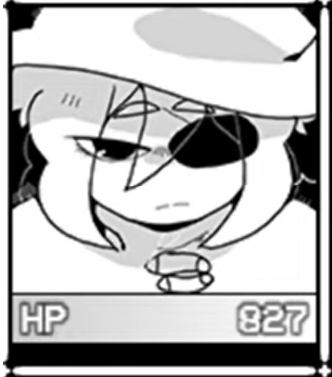
Battles keep getting easier. This is true both for the reason that Siffrin keeps growing stronger even when all enemies stay the same, but also for the reason that you, the player, learn more about the battle system and the various encounters, until you've learned perfect boss clear strategies just from repetition. Have you ever watched a speedrunner play Pokemon? They've played this game so many times, they could do it blindfolded and sleeping. Your own knowledge and Siffrin's new strength work in tandem to trivialize the game's entire combat system as the game progresses.
(Is it still fun? Playing it over, and over, and over again? Is it?)
You and Siffrin are in sync, your experience making everything trivial.
As time goes on, Siffrin grows to care less and less about performing right for their party and more and more about going fast. A huge moment in his character is marked by the end of Act 3; because of story events I won't delve too deeply into, Siffrin has grown afraid of trying something new. And his options of escape are closing in. They need an answer, and they need it fast. He doesn't have the time or patience to dumb himself down, so you unlock one new skill.
It doesn't occur with level up, or with a quest, or anything at all. At the start of Act 4, it simply appears in Siffrin's Craft skills.
(Just attack.)
No pun. No joke. Just attack. Once you notice, the effect is immediate - here you have it, a clear sign of how jaded Siffrin has become, right at every encounter. And it's a damn good attack, too! The only available attack in the game that deals "massive" damage against all enemies. Because it doesn't add any jackpot points (at least, it's not supposed to), you set up a combo with everybody else, but Siffrin simply tears away at the enemy with wild abandon. Seperated from the rest of the party by the virtue of no longer needing to contribute to team attacks (most of the time. It's still useful if they do, though).
Once again, an aspect of the battle system enhances the degree of separation between Siffrin and the static characters of his play. You're incentivized to separate him, even.
Additionally, there are two more skills to learn. They're the only skills that replace previous skills. You only get them at extremely high levels, the latter of which I didn't even reach on both of my playthroughs.
The first, somewhere in the level 70 range, Rose Printed Glasses, a paper type craft skill, is replaced by Tear You Apart. It's still a pun about paper, but remarkedly more vicious.
The second is even more on the nose. At level 80, In A While, Rockodile!, a rock type craft skill, is replaced by the more powerful Rock Bottom.
I didn't get to level 80. If you do, you pretty much have to do it on purpose. You have to keep going much longer than necessary, as Siffrin is just done. And the last skill he learns is literally called Rock Bottom.
What do I even need to say, really.
Your party doesn't stay static forever, though.
By doing their hangout quests, side quests throughout the loops that result in Siffrin and the character having a heart to heart, all of them unlock what I'd call an "ultimate" skill. You know the type - the character achieved self-fulfillment, hit rank 10 on their confidant, maxed out their skill tree, and received a reward for their trouble.
These skills are massively useful. My favorite is Odile's - it makes one enemy weak to all Craft types for several turns, which basically allows you to invalidate the first and third boss, as well as just clown on the King, especially once Siffrin starts racking up damage.
But the thing is. In Act 3, when you first get them, yeah, they're useful. But... do you need them? After all, they're such a hassle to get. You need to do the whole character quest again, you can't loop forward in the House or you'll lose them. If you want to take these skills to the King, you need to commit. Go the full nine-yards and be nice to your friends and not die and not skip forward or skip back. Which is annoying, right?
Well, I sure did think so during Act 4. After all, a base level party can still defeat the King, just with a few more tricky pieces involved. Siffrin can oneshot almost all basic enemies by the time of Act 4. It's this exact evalutation that you, the player, go through everytime you return to Dormont. Do I want this skill, still? Would it not be faster to go on without it? I'm repeating myself, but that's the thing! That's what Siffrin is thinking, too!

I also want to take a quick moment to note, here - all skills gained from hangouts have art associated with them, which no other skills do. This feature, the nifty art, hammers home these as "special" skills, besides just how they're unlocked.
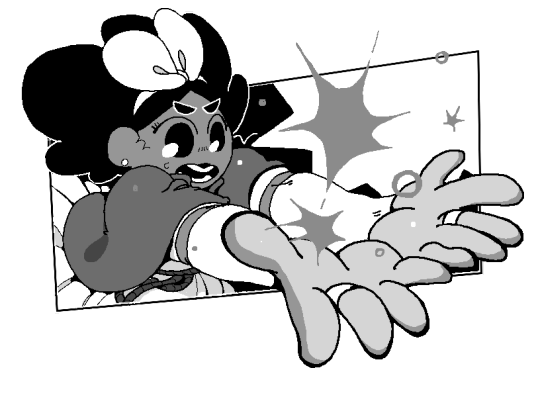
Siffrin also has one skill with associated art.
Yeah, you guessed it, it's (Just attack.)
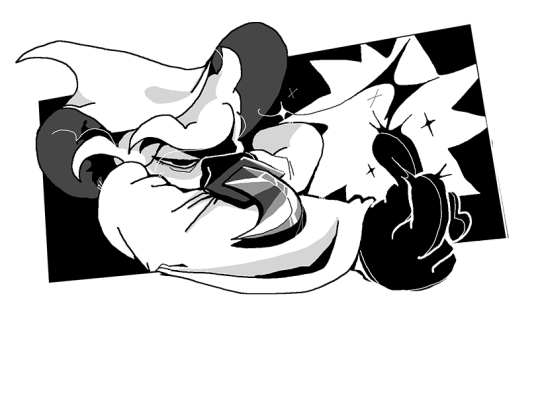
At first, helping the characters is tied to a hefty in-game reward, but that reward loses its value, and in return devalues helping Siffrin's friends every loop. It's too tedious for a skill that'll make a boss go by one turn faster. You, the player, grow jaded with the battle system. Grinding experience isn't worth it, everybody's highest levels are already recorded. Fighting bosses isn't worth it, it's much faster to loop forward.
Isn't this what all endgame in video games looks like? You already beat the final boss, and now... what challenge is left? Is there a point to keep playing? Most games will have some post-game content. A superboss to test your skills against, but ISAT doesn't have any of that. You're forever left chasing to the post-game. That's the whole point - to escape the game.
As most games get more difficult as time passes, ISAT only gets easier. The game becomes disinterested in expanding its own mechanics just as I ran out of new things to fight after 100%-ing Kingdom Hearts 3. Every encounter becomes a simple game of "press button to win."
The final boss just takes that one up a notch.
Spoilers for Act 5 ahead boys!
In Act 5, Siffrin utterly loses it. His last possible hope for escape failed him, told him there's nothing she can do, and Siffrin is trapped for eternity. So of course, they go insane and run up the entire House without their party.
This just proves what you already knew - you dont need the party to proceed. Siffrin alone is strong enough. And here, Siffrin has entirely shed the facade of the jokester they used to be. Every single skill now follows the (Just attack.) naming conventions. Your skills are: (Paper.) (Rock.) (Scissors.) (Breathe.)
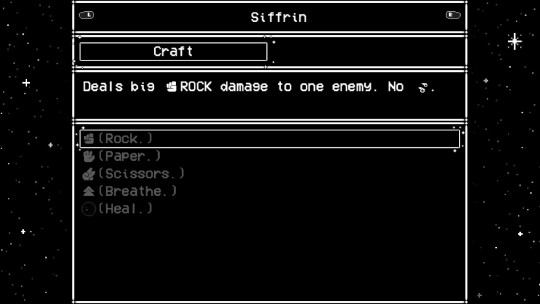
To the point. Not a moment wasted, because Siffrin can't take a moment longer of any of this. Additionally, his level is set to 99 and his equipment becomes fixed. You can't even pick up items anymore! Not that you needed them at this point anyway, right? Honestly, I never used any items besides the Salty Broth since Act 2, so I stopped picking items up a long time ago. Now you just literally can't.
Something I've not talked about until now - one of the main equipment types in this game are Memories, gained for completing subquests or specific interactions and events. They all by and large have little effects - make Odile's tonics heal more, or have Mirabelle cast a shield at the start of combat. For the hangout events, you also gain an associated memory that boosts the characters' stats by 30. It lets them keep up with Siffrin again! A fresh wind! Finally, your party members feel on par with you again!
...For a time. And just like that, they're irrelevant again, just as helping them gave Siffrin a brief moment of hope that the power of friendship could fix everything.
In Act 5, your memory is set to "Memory of Emptiness." It allows you to loop back in the middle of combat. You literally can't die anymore. Not that Siffrin could've died by this point in the first place, unless you forgot about the King's instant-kill attack. This one memory takes away the false pretense that combat ever had any stakes. Siffrin's level being set to 99 means even the scant exp you get is completely wasted on them. All stakes and benefits from combat have been removed. It has become utterly pointless.
Frustrating, right? It's an artistic frustration, though. It traps you right here in Siffrin's shoes, because he hates that all these blinding Sadnesses are still walking around just as much. It all inspires just a tiny fraction of that deep rolling anger Siffrin experiences here in the player.
And listen, it was cathartic, that one time Siffrin snapped and stabbed the tutorial Sadness, wasn't it? Because who enjoys sitting through the tutorial that often? Siffrin doesn't. I don't, either.
So, since combat is an useless obstacle now meant to inspire frustration, what do you do for a boss? You can't well make it a gameplay challenge now, no. The bosses of Act 5 are an emotional challenge: a painful wait.
First, Siffrin fights the King, alone. This is already nervewracking because of one factor - in every other run, you need Mirabelle's shield skill, or else you're scripted to die. You're actually forced to fight the King multiple times in Act 3, and have to do it at least once in Act 4, though you'll likely do it more. Point is: you know how this fight works.
You know Siffrin's fight is doomed from the outset, but all you can do is keep slinging attacks. Siffrin is enough of a powerhouse to take the King's HP down, what with the healing and buff skills they have now, not to even mention you can just go all in on damage and then loop back.
(And no matter which way you play it, whether you just loop or use strategically, it reflects on Siffrin, too. Has he grown callous enough not even death will stop their mission? Or does he still avoid pain, as much as he can?)
This fight still allows you the artifice of even that much choice, not that it matters. The other shoe drops eventually - Siffrin becomes slower, and slower. Unsettling, considering this game works on an Action Gauge system. You barely get turns anymore. The screen gets darker, and darker. Until Siffrin is frozen in time, just as you knew he had to be, because you know how this encounter works, know it can't be cleared without Mirabelle.
And, then, a void.
Siffrin awakens to nothingness. The only way to tell you've hit a wall is if Siffrin has no walking animation to match your button inputs. You walk, and walk, until you're approached by.... you. The next enemy encounter of the game, and Siffrin's absolute lowest point: Mal Du Pays.

Or, "Homesickness," in english. If you know the game, you know why it's named this, but that's not the point at the moment.
Thing is, where you could damage the King and are damaged in turn, giving you at least a proper combat experience, even if its doomed to fail, Mal Du Pays has no such thing.
You can attack. You can defend. But it is immune to all attacks. And in return, it does nothing. It's common, at least, for undefeatable enemies to be a "survive" challenge, but nope. The entire fight is "press button and wait." Except, remember the previous fight against the King? The entire time, you were waiting for the big instant death attack to drop. That feeling, at least for me, carried forward. I was incredibly on edge just waiting for the other shoe to drop. And, as is a pattern, Siffrin is, too. As Siffrin's attacks fail to connect, they start talking to Mal Du Pays.
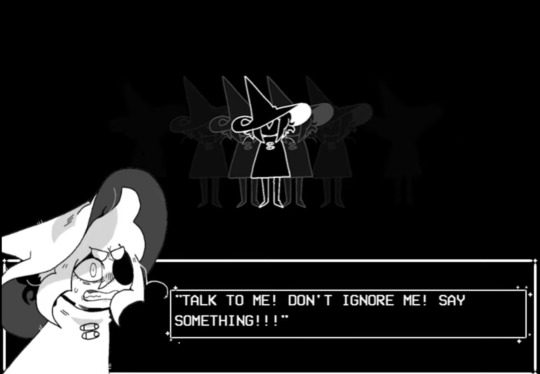
But he gets no response, as you get no attacks to strategize around. The wait for anything to happen is utterly agonizing. You and Siffrin are both waiting for something to happen. This isn't a fight. It just pretends to be. It's an utter rugpull, because Siffrin was so undefeatable for most of Act 4 and all of Act 5 so far. It's kind of terrifying!
and it does. It finally does something. Ma Du Pays speaks, in the voice of Siffrin's friends, listing out their deepest fears. I think it's honestly fantastic. You're forced to just sit here and listen to Siffrin's deepest doubts, things you know the characters could not say because it references the timeloops they're all utterly unaware of. This is all Siffrin, talking to himself. And all you, all Siffrin, can do, is keep wailing away on the enemy to no effect whatsoever.
So of course this ends with Siffrin giving up. What else can you do?
And then Siffrin's friends show up and unfreeze them and it's all very cool yay. The pure narrative scenes aren't really the main focus but I want to point out here:

A) Mirabelle is in the first party slot here, referencing how she's the de facto protagonist, and Bonnie fills in the fourth slot left empty, which shows all characters uniting to save Siffrin
B) this is the only instance of the other party members having act specific battle icons: they're all smiling brightly, further pushed by the upbeat music
C) the reflecting shield Mirabelle uses to freeze the King uses a variation of her hangout skill cut in, marking it as her true "final" skill and giving the whole fight a more climatic feeling.
It's also a short gameplay sequence with Siffrin utterly uninvolved in the battle. You can't even see them onscreen. But... it feels warm, doesn't it? Everybody coming together. Siffrin doesn't have to fight anymore.
At last, the King is defeated. Siffrin and co. make for the Head Housemaiden, to have her look at Siffrin's sudden illness. Siffrin is utterly exhausted, famished, running a fever. And this isn't unexpected - after all, their skills in Act 5 had no cooldown. For context, instead of featuring any sort of MP system, all skills work on a cooldown basis, where a character can't use it for a certain number of turns. The lowest cooldown is actually Siffrin's Knife to Meet You, which has a cooldown of 1. In universe, this is reasoned as the characters needing a break from spamming craft in order to not exhaust themselves.
Siffrin's skills in Act 5 having no cooldown/being infinitely spammable isn't a sign of their strength - it's a sign that he refuses to let himself rest in order to rush through as fast as possible.
Moving on, Siffrin panics when seeing the Head Housemaiden, because seeing her means one thing: the end. Prior to this in the game, every single time you beat the King, the loop ends when you talk to the Head Housemaiden.
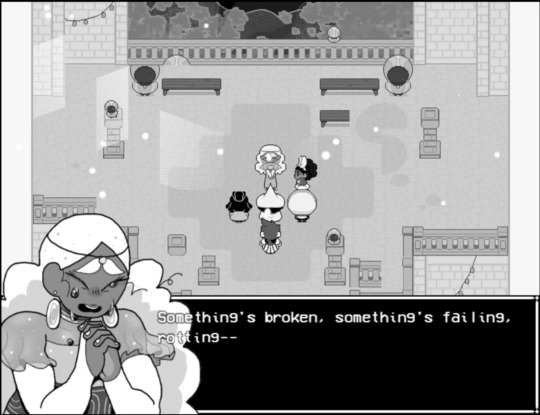
Reality breaks down, the whole shebang. It's here that Siffrin realizes - they don't want the loops to end, because the end of their journey means their family will leave, and he'll be alone again. The happiest time of his life will be over.
Siffrin goes totally ballistic, to say the least.
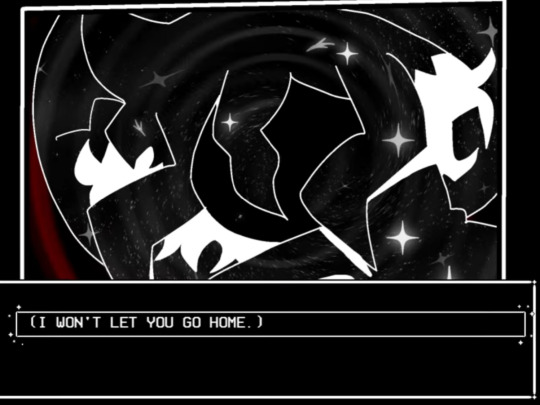
As it turns out (and was heavily foreshadowed narratively), Siffrin has been using Wish Craft to subconciously cause the timeloop because of their abandonment issues. It's rather predictable if you paid attention to literally anything, but it's extremely notable how heavily Siffrin is paralleled to the King, the antagonist they swore to kill by themself at the start of Act 5. The King wants to freeze Vaugarde in time because it is, in his mind, "perfect," for accepting him after he lost his home - a backstory he shares with Siffrin.
Siffrin has become the exact antagonist he swore to kill, and it's shown by how the next fight utterly flips everything on its head.
Siffrin is the final boss.

In a towering form made of stars, Siffrin looks down at their friends. His face is terrified, because of his internal conflict; he can't hurt his friends, but he can't let them go, either. The combat prompt is simply changed to "END IT!"
This fight is similar to the previous, in that you just need to wait a certain number of turns until its over. However, this time, it's not dreadful suspense. It's... confusion, and hesitance.
You have two options for combat: Attack your friends, or attack yourself.
And... you don't really want to do either, I think. I certainly don't. But what else can you do? It's Siffrin's desires clashing in full force. Attack your friends, and force them to stay? Or attack yourself, and let them go safely without you?
Worth noting, here - when you attack Siffrin's friends, you can't harm them. Isabeau will shield all attacks. And when you attack yourself, Mirabelle will heal you back to full. And the friends don't... do anything, either. How could they? Occasionally, Mirabelle heals you and Isabeau shouts words of motivation, but the main thing is...
(Your friends don't know what to do.)
None of them want to harm Siffrin. Both sides simply stare at each other, resolute in their conviction but unwilling to end it with violence. It's of note that this loop, the last one, is the only loop where the King isn't killed. Just frozen. And now here is Siffrin, clamoring for the same eternity the King was. Of course everything ends in a tearfilled conversation as Siffrin sees their friends won't leave him, even after the journey ends, but I still have to appreciate this moment.
Siffrin is directly put in the position with their friends as his enemies, forced to physically reckon that keeping them in this loop is an act of violence, against both their friends, and against himself.
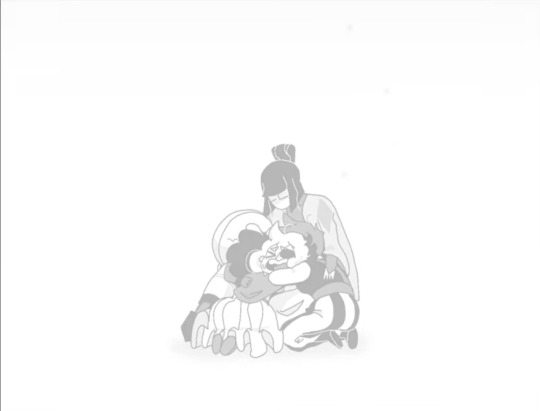
It's a happy ending. But... what does it mean?
Of course, ISAT is obviously about the fear of change. Siffrin is afraid of the journey ending, and of being alone. However, ISAT is also a game about games. Siffrin is playing the same game, over and over, because it's comforting. It's familiar. It's nice, to know exactly what happens next. These characters might just be predictable lines of dialogue, but... they feel like friends. Have you ever played a game, loved it, put countless hours into it, but you never finished it? Because you just couldn't bear to see it end? For the characters to leave your life, for there to be a void in your heart where the game used to be?
After all, maybe it became part of your routine! You play the game every day, slowly chipping away at it for weeks at a time. For me, I beat ISAT in four days. It utterly consumed me during this time. I had 36 hours of playtime by the end. Yeah, in that week, I did not do much more than play ISAT.
And once i beat it, i beat it, again. I restarted the game to see the few scenes I missed, most specifically the secret boss I won't talk about here. I... couldn't let go of the game yet. I wanted to see every scrap I could. I still do. I'm writing this, in part because I still do. It's scary to let go.
Ever heard the joke term of "Postgame Depression?" It's when you just beat a game, and you're suddenly sad. Maybe because the ending affected you emotionally and you need to process the feelings it invoked, or you search for something that can now fill your time with it gone.
The game ends, for real this time, the last time you talk to the Head Housemaiden. But Siffrin gets... scared. What if everything loops back again? And so, his family offers to hold his hand. They face the end, together.
For all loops, including the ending, you never see what happens after. After they leave the loop for good. Because the loop is the game itself. It's asking you to trust that life goes on for these characters, and it holds your hand as it asks you to let go. There's a reason for Siffrin's theater metaphors. He is the actor, and the director, asking everyone to do it over one more time. He's a character within the game, and its player.
There's a reason I talked about endgame content. This, the way it all repeats, there's nothing new, difficulty and stakes bleed away as you snap the game over your knee - it's my copy of White 2 with two hundred hours in it. It's me playing Fire Emblem Awakening in under 3 hours while skipping every cutscene. Are you playing for the sake of play, for the sake of indulging in your memories, because you're afraid of the hole it'll leave when you stop?
Of note: the narrative never condemns Siffrin for unwittingly causing their own suffering. He's a victim of circumstance. It's seen as endearing, even, that Siffrin loves their friends to the point of rather seeing the world destroyed than them gone. But Siffrin is also told: we'll stay with you for now, but we'll part ways eventually. And one day, you'll have to be okay with it.
Stop draining the things you love of every ounce of enjoyment just because you're afraid of what happens next. I'm not saying to never play your favorite games again. Playing ISAT a second time, I still had a lot of fun! I saw so many new things I didn't before, and I enjoyed myself immensely, reading the same dialogue over and over. But... it makes me look at other games I love and still play, and makes me ask... is this still fun? Do I still need to play this game to enjoy it? Even writing this is an afterimage of my enjoyment, but it's a new way to interact with the game, to analyze it through this lens. Fuck, man, I write fanfiction. Look at me.
All of this, fanart, fanfic, analysis, is a way to prolong that enjoyment without making yourself suffer for it. Without just going through the motions of enjoyment without actually experiencing any. But one day, the thing you love won't be fun to talk and write and draw about. And it's okay. You'll have new things to love. I promise.
In the end.... I'm certain I'll replay ISAT one day. Between great writing, art, puzzles and unresolved mysteries, it's my shoe-in for game of the year.
But I won't replay it for quite some time. I've had enough, for now, so I let my love take other forms.
Siffrin is never condemned, because love is no evil. Be it love for another person, or for a game. And please, if you're overempathetic - it's still a game, at the end of the day. The great thing about games is that you can always boot them up again, no matter how long its been.
A circle within a circle indeed.
To summarize:
The repetitiveness of ISAT's combat, lack of new enemies, and Siffrin's ever increasing strength eventually allows you to snap the combat over your knee, rendering it irrelevant and boring. Though this may seem counterproductive at first, it perfectly mirrors how Siffrin has also grown bored with these repeated encounters and views them only as an obstacle to get past. The reflection of Siffrin's own tiredness with the player's annoyance increases the compassion the player has for Siffrin as a character.
Additionally, the endgame state of the combat system serves as commentary on the state of a favorite game played too often, much like how Siffrin has unwittingly trapped themself in the loop. Despite the game having no more challenge or content left to over, a player might return to their favorite game anyway, solely to try and recreate the early experience of actually having fun with it. This ties into ISAT's metanarrative about the fear of change and refusal to let go of comfort even when the object (here, your favorite video game) offering that comfort has become utterly bereft of any substance to actually engage with. Playing for the sake of playing, with no actual investment to keep going besides your own memories.
Later on, stripping away even the pretense of strategy for a "press button and wait" format of final bosses highlights the lack of options at Siffrin's disposal and truly forces the player into their shoes. Truly, the only way to win is to stop playing.
#feli speaks#in stars and time#isat#isat spoilers#lays down on floor. it's done. it's done#i actually narrowed down in scope to just focus on the combat by the way. and this is like. several thousand words
2K notes
·
View notes
Text
i've had this pathologic 3/quarantine post sitting in the drafts for ages that criticizes sanity mechanics as a concept (i think they're generally worse at generating ludonarrative harmony compared to physical health mechanics). but i didn't want to just be critical, so i've also been thinking for awhile about what i think could be added to really improve the game's sanity system and make the mechanic more interesting.
basically, i think that high mania/apathy should have an actual impact on gameplay that isn't just "your health meter starts decreasing" or "you can't start dialogue until you normalize your psychosis meter" or "a craaaazy glitch filter appears over your vision". these just feel like inconveniences, they don't instill the type of visceral desperation in the player that is necessary for this to work as the game's new sole survival mechanic. my biggest suggestion for how to make the sanity mechanic feel more visceral would be to allow the bachelor to start conversations even at high levels of mania or apathy, but with his mental state influencing how he behaves in conversation. grey out the friendly, cooperative dialogue options, so that the player can see the potential to choose a diplomatic option, but can't select it. force the player to choose the worst, most aggravated responses instead when dankovsky is under stress. and of course, if he's being an asshole, then the people he's talking to should withhold key information about potential clues or locations where he could access resources. life gets harder.
but then i realized i was just reinventing depression quest but as a walking simulator.
#mine#pathologic#patho meta#pathologic 3#i'm listening to jacob geller's ''who's afraid of modern art'' video essay while i crochet and he brought up depression quest#which made me remember that game which made me remember this idea i had#context for people who weren't sad terminally online teenagers in 2015: it was an utterly inoffensive game#that the online right wing used as casus belli for the whole gamergate hate brigade
135 notes
·
View notes
Note
What if cal gave bode one of his lightsabers the other half? or?
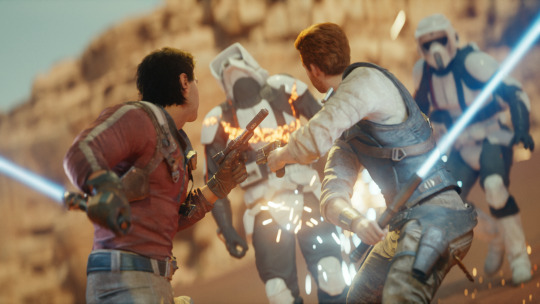

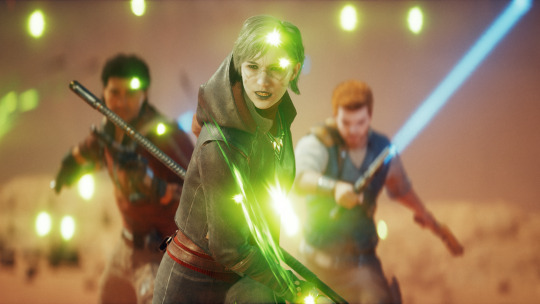
That would've been really cool. Had Bode's identity been discovered earlier, had his fear not kept him from trusting the Hidden Path, he would've been an even more powerful ally for Cal and the Mantis Crew.
Sometimes I think about how, aside from Cere and Cal facing Vader at the end of Fallen Order, Cal has never fought alongside another lightsaber in the games. Every other saber was held to his head by an Inquisitor, a Sith Lord, a Memory, a Raider, or a Fallen Jedi.
Trilla, Masana, Ghost Tapal, Malicos, Vader, Dagan, Rayvis' Raider lieutenants, and Bode.
Cal needs powerful foes to challenge him, and allies who help but never surpass his (aka the player's) ability. Ludonarrative harmony is important when balancing the story and gameplay elements, and Cal's role as a lone warrior plays into both.
But the Jedi series also cares a lot about symbolism when it comes to lightsabers. In Fallen Order, Cal's entire character arc is represented by the condition of Jaro's saber. He wrestles with his identity throughout Survivor, and after fighting so many fallen Jedi and their kyber-bled weapons, he builds pyres for Cere, Cordova, and Bode. Any hope of a Jedi ally is gone.
Knowing Cal's saberstaff can split into two pieces, I'm curious to see if the third game would incorporate this with a (potential) Force-sensitive Kata story? But that's probably a whole different post.
#just thinking about the symbol of the Jedi being wielded against Cal over and over and over#how Cal was given his master's saber through terrible circumstances#and how he may end up in a position to pass that saber on again#(but NOT die! that's also a whole different post)#thanks anon! sorry for going way off topic of your original question#asks#cal kestis#bode akuna#merrin#jedi survivor#star wars jedi survivor#jedi survivor mod#jedi survivor spoilers#photomode#star wars
108 notes
·
View notes